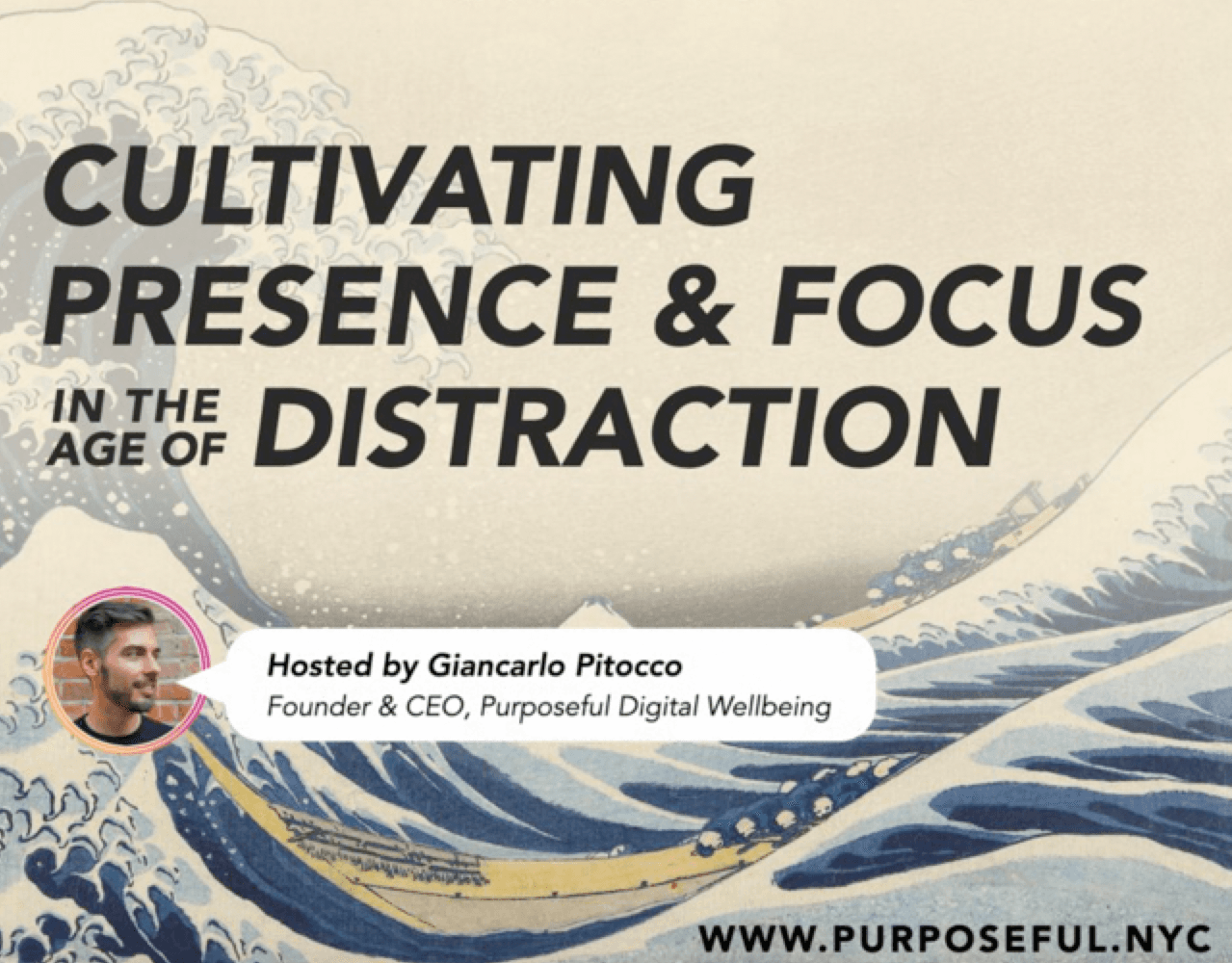
Giancarlo Pitocco is on a mission to encourage people to put down what he calls our “digital Doritos.” In Digital Wellbeing Essentials, the second session of Knopman Marks’ new, 8-week Essentials to Thrive series, Pitocco explored the role digital devices play in our lives. Founder & CEO of Purposeful Digital Wellbeing, he left a successful career in tech, most recently at Facebook/Instagram, to help others reclaim their attention from the lure of technology.
Pitocco views our use of digital devices as a window into the larger question of how we’re spending our time. Are we online or offline more often? Do we use tech to procrastinate or to further our goals? He believes we can reduce the digital distractions that keep us from living the life we want.
After all, when polled at the start of the masterclass, 87% admitted they reach for their smartphone upon waking most days or every day. Pitocco’s masterclass examined how we can cultivate presence and focus in the age of distraction.
3 Big Ideas to Boost Digital Wellbeing
- Control where you direct your attention. We can control where we give our attention or let others control it. When we turn off alerts and notifications that don’t add value, or decline meetings that aren’t the best use of our time, we are cultivating focus and training others how to interact with us. “We are the DJs of our own attention,” he says. “We get to choose.”
- Use tech to create your life, not escape it. A healthy relationship with technology is when we use it in service of our needs, values, and aspirations. Instead, we often use tech as an escape hatch. “Tech can become an unconscious, hypnotic distraction that keeps us from focusing on what’s important,” Pitocco notes. He prefers to see tech devices as supporting actors in our lives, not the stars.
- Our relationship with digital devices reflects our relationship with ourselves. Pitocco is curious about what we’re distracting ourselves from. He knows from working at tech companies that they aim to keep people hooked by any means necessary to “harvest your time and attention to sell to advertisers.” Time spent on the internet is climbing while the time we spend interacting with others is declining, along with our happiness, Pitocco says, noting, “When we put down our devices, we can engage in real life.”
Q&A with Giancarlo Pitocco
- What was your biggest challenge personally when limiting your use of digital devices?
I began that journey when I worked at Facebook and Instagram, where I had to use the very tools I see as distractions. I was in the belly of the beast. It was 2016. There were accusations that Facebook had been used to manipulate the elections. When I saw the dismissive reaction of the leadership, I was shocked and concerned… That really shook me out of complacency. I did a deep dive into my digital usage. I discovered I was in consumption mode 80 percent of the time, rather than creating or being productive. I was distracting myself from myself, from my life. This was a turning point. I decided to remove all tech from life that I could.
- What changes occurred when you removed tech from your life?
Over the next month or two, there was a total transformation of my life. I had the space and time for creativity to grow… I bought a camera and started taking pictures. I took time for a meditation practice. I traveled. I learned a language. I started seeking more meaningful experiences. My friends noticed a difference and asked, “What happened? You’re on fire now.” When I put down my devices, I was able to examine what kind of life I wanted to live.
- What does digital wellbeing mean to you?
Digital wellbeing means reframing my relationship with technology. I started living a better life even when I had tech back in my life. I had more balance. The story of digital wellbeing and tech is really a Trojan horse into our lives. When I put tech down, I became a more active part of my community, I made new friends, and I flourished in ways I had not since I was a child.
If you missed Pitocco’s session, a recording is available in the Training Center at www.knopman.com. You can access his worksheets to explore recommendations he outlined in his session, and also see the recording and materials from Knopman Marks CEO Liza Streiff’s session on motivation.
Register here for the Essentials to Thrive series, and join us Wednesday at 12:30 pm ET for the third live-streaming masterclass: Mindset Essentials – Propel yourself to the highest level with a leadership mindset. The speaker, Rich Bello, is the founder of Arootah, The Center for Inspired Action, and co-founder of Blue Ridge Capital.
Written by Suzanne Riss
Suzanne Riss is an author and Director of Communications at Knopman Marks Financial Training. Previously the award-winning Editor-in-Chief of Working Mother magazine, she is a fierce advocate for issues facing working moms and an authority on work/life trends. Her expertise has been tapped in interviews by The New York Times, The Wall Street Journal, Good Morning America, the Today Show, and CNN. Suzanne's third book, Work Disrupted, published by Wiley, was released in January 2021.
Related posts
- Read more
Introducing How to Finance: A Beginner’s Guide to the Industry
One of our primary roles as educators is to bridge gaps in knowledge. Our newest course, How to F
- Read more
How Intentional Rest Boosts Performance
Though you may think that studying all afternoon without a break will improve your performance, r
- Read more
Research Analyst Exams Update – Changes to S86/87
In late February, FINRA filed with the SEC revisions to the content outline and selection specifi


